On the morning after last week’s EKK wrap was sent, I got a 6:30 a.m. email response from Uncle George Kahumoku of Maui . . . don’t people ever sleep? But it’s great to see that people are reading and appreciating the story for each Monday’s EKK. Here we go . . .
Last year at EKK, Alan Akaka ended the program with, “Please invite us back again!” and here they are again sharing their awesome line-up of kumu at the AMC “Community Aloha Night.”
It was another wonderful evening at EKK with the magical Beamer aloha dust sprinkled all over the audience. Kaliko Beamer-Trapp led the ‘ukulele hour in his inimitable style. I managed to catch a quick story he was telling the group about Grandma Beamer who told the kids to go down to the beach and find 2 shells that were identical and then come home. Of course, finding 2 identical shells is near impossible but it kept the kids outside for a good length of time. When they came home they played with the shells and fell promptly asleep. This story led to the group playing Grandma’s song Pupu Hinuhinu (Shiny Shell Lullabye).
Moanalani welcomed everyone with an ‘oli.
You could hear a Kukui nut drop in the hush as everyone in the Jasmine ballroom held their breath in silent anticipation of Keola’s words of Aloha . . . words that are backed up with a life lived full of love which he has been sharing with the world through the popular Aloha Music Camp — second time held on Kaua’i. As artistic director of AMC he makes sure that they recruit top-notch instructors to fulfill the mission inspired by Aunty Nona Beamer’s daily message to the family – Malama Kou Aloha – Keep your Aloha. This Hawaiian philosophical practice “was a way of being” that helps one to keep that light so you can see the aloha in others. Of course, enticing campers to Kaua’i, a slice of Heaven on Earth, has been a smart move. Learning to live aloha in a place that breathes aloha is a move in the right direction.
So simple … so profound. And in every way, they practice this in their daily lives.
Keola shared his slack key expertise playing Makee Ailana – a song about the island in the pond by Waikiki Zoo where lovers used to hang out; today the Zoo parking covers the pond that was once there. Progress!
Keola spoke about the place where he grew up on the slopes of Mauna Kea on a Hawaiian Homelands ranch owned by his Uncle. Mauna Kea was as much a part of his family as the ‘ohana. Out of this experience came the song The Beauty of Mauna Kea introduced with the haunting sounds of the nose flute, a chant, his nahenahe style of singing to the gentle strumming of his slack key guitar, and the majestic hula by Moanalani.
Moanalani is a stoic woman who appears like a Hawaiian Amazon but her actions are laced with love and compassion as she moves about greeting, hugging, and just acknowledging the presence of people around her. One of my volunteers pointed out that she and all the artists took time to thank those in the background who helped to make the evening go smoothly . . . so much appreciation to be appreciated.
When Moanalani gets up to dance, her elegance of movement reminds us that our physical self can be an expression of great magnificence. Her every motion exudes emotion as she reaches up to the heavens, bows low to the ‘aina, and sways her womanly physique to visually speak the lyrics for our eyes and our hearts to understand. Half a century late, I finally get what my kumu hula, Helen Kekua, meant when she was trying to get me to show some feeling in my hula movements. (Sigh . . .)
Keola loves his beautiful home in Maui which is so close to the beach; he likes to go there with his beach guitar to practice, especially when there is yard work or anything to be done around the house. There is that ever-present quiet humor which slips out from time to time when Keola tells a story, this time about the ‘ulili bird or “wandering tattler” that he was watching on the shoreline. Plucking sounds on his guitar to echo the bird’s mating call perked the two-legged ‘ulili to attention, and Keola thinks to himself, “This is one lonely bird.” He said that the bird who was quizzically sizing up Keola was probably thinking to himself, “What kind of egg did you come out from?” Keola called on Jeff Peterson to join him with his guitar while Moanalani played the ipu heke and sang the bird’s call-back trills in the chorus.
Keola’s nahenahe style of singing was a great way to bring everyone into focus and to settle in for an evening of sharing by their eight illustrious AMC kumu. He introduced Alan Akaka, a skillful teacher and an illuminating influence whose heart and soul keeps steel guitar alive and well in Hawai’i. Alan, in turn, brought to the stage each artist asking them to give a teaser sample of their musical specialty; it was like a wine tasting of musical talents.
Konabob Stoeffer, a key player in the coordinating of AMC, demonstrated his innovative invention – a very thin and tall 3-string koa stick slack key bass which could make significant sounds in the lower register. Herb Ohta Jr. who follows in the giant footsteps of his Ohta-san Dad, charms everyone with his light and delightful lullabye melody. Maui Boy Kevin Brown shares the rich sounds of a traditional slack key standard.
Kaliko Beamer-Trapp rattled off in ‘olelo Hawai’i, punctuating his brief oratory with intermittent strums on his ‘ukulele. His story is well known — he came from the Isle of Wight off the shores of England and in 1996 became the hanai son of Aunty Nona Beamer and younger brother of Keola. He is responsible for much of the translations of the English lyrics into Hawaiian poetry. As language teacher at UH Hilo’s Ka Haka ‘Ula o Ke’elikolani Hawaiian Language College, he plays a major role in spreading the Hawaiian language to all who wish to learn to speak the language. You can even go to oleloonline.com to learn to speak Hawaiian from Kaliko.
Jeff Peterson and Alan Akaka are neighbors in Kailua; both just returned from Calcutta, India where they attended the International Steel Guitar Festival. Tau Moe of Laie first introduced the instrument to India in 1919 and spent time traveling to India in the 1930’s and 1940’s. Jeff said it was amazing to watch Alan play the Hawaiian steel guitar in India; it’s been a long time coming for the Hawaiian Steel to revisit India. Jeff pointed out that in India the musicians play it with an accent.
Uluwehi Guerrero, the songbird of Maui, teased the audience with his heavenly voice to the song Kipahulu for a too-short moment but a chicken skin moment none-the-less. He was responsible for the musical arrangements for Keali’i Reichel for many years but now spends much time in Japan working with the halau ladies known as Uluwehi’s “butterflies”, extraordinary hula dancers.
Liko Puha who traveled all the way from California was a former student of Kalena Silva. He imparted words of wisdom to the audience, “You need to try the AMC; put it on your bucket list.”
In addition to their outstanding musical talents, each kumu delivers their unique brand of humor. Alan, when he retires from music, can do the comedy club circuit with his spontaneous antics. He says that Uluwehi’s surprising one-liners just ooze out of him. Uluwehi also tells great small kid time stories, embellished with pidgin English that reminds all of us local folks about our humble barefoot “hanabata” days. Herb, also delivers one-liners with a deadpan expression; he doesn’t say much, but what he says stays with you. Liko Puha with his loud chanting and equally loud giggle has humor written all over his expressive face. Soft spoken Kevin as a wealth of hilarious stories from his long musical life. Kaliko spits it all out in rapid-fire Hawaiian but those who get it are full of chuckles. Konabob at one end and Jeff Peterson as the other end, are the pillars that hold it all together for the group.
The kumu joined together in a group song with each artist taking a turn playing pa’ani or musical interludes. With a nod of the head or calling out a name, the musical ball was passed from one artist to another, and each gave his special twist to the song. Kaliko led off the individual performances with the zesty Holoholo Ka’a backed up by the other seven artists.
Liko, who admits to being an administrator at a Junior College in California for his day job, sang a song composed by Lot Kauwe and made famous by Bruddah Iz. Lot wrote a lot of love type songs, so Aloha Ka Manini is about fish. “But really! . . . is it about fish?” he questions with a twinkle in his voice and rolling eyes on his jovial face.
Herb was asked to demonstrate the great sound of the Kamoa ‘ukulele which this week was an electric acoustic instrument. Herb obliged with the lively Sophisticated Hula and everyone joined in making that the longest debut for any Kamoa ‘ukulele that was given away at EKK.
Calvin Hoe, the AMC kumu whose task is to show campers how to make their own Hawaiian instruments the traditional way, shared Mary Kawena Pukui’s song Ke Ao Nani, known as Baby Hula, which he learned from his kumu hula Auntie Nona Beamer. Moanalani, clicking river rocks in her hands, and Mauli’ola Cook, keeping the beat with the bamboo pu’ili, danced this favorite song for children. A teacher at the Hakipu’u Learning Center, a Hawai’i Public Charter School at Windward Community College, Calvin teaches students how to plant taro, play music and dance the hula. “I feel so fortunate to live in a place like this and I am even more lucky because I know I am lucky.”
Jeff shared an instrumental song with Indian tunings and sounds inspired by his recent visit to the Classic Steel Guitar competition in Calcutta. It sounded amazingly like it was being played on an Indian instrument instead of a slack key guitar. Since Tau Moe first introduced the instrument to India nearly a century ago, the musicians in India have altered and embellished the instrument so much that some steel guitars have as many as 40 strings that deliver a richness of sounds. The Kika Kila (geetah-steel-ha), meaning steel guitar, has evolved into many variations in India.
Herb Ohta, Jr. shared a song he learned from the legendary Ledward Kaapana. It’s on Led’s Life Solo CD and is actually a Russian Folk Song that is also known as Turkey In the Straw; slack key artists call it Glass Ball Slack Key.
Kevin Brown wanted to share Dennis Kamakahi’s most famous song because Kaua’i is where Dennis played his last concert before he passed on. At each concert on Kaua’i, Dennis always said, “I like to start my tour on Kaua’i because it’s my barometer on how the tour will go.” If he could not start it here, he always tried to end it here. As soon as Kevin began to sing, the entire audience joined in and raised their voices in unison to Kauai’s favoriteKoke’e. It was definitely chicken skin and Kevin wraps it up with, “Dennis would be so proud!” Kevin and the Brown family ranked high as Dennis’s close friends.
Uluwehi Guerrero has an expression of calmness that belies the twinkle with which he tells stories. Invited to perform at the President’s Black Tie Affair at the Tournament of Roses for the Rose Bowl parade, he was faced with an audience of 450 of the most conservative, wealthy and influential people.
Having learned from the promoter that the previous year, Jersey Boys did not go over big with this crowd, he decided against a Hawaiian program which they would not understand anyway. He chose instead to sing a song from the Hapa-Haole Music era which the Chamber of Commerce commissioned Silverwood to write in 1919 to encourage people to come to Hawai’i. Honolulu, I’m Coming Back Again! captured and held their attention; the promoter told him, “This is the first time the people did not leave for the final act.”
It was a most appropriate song for the EKK group as many of the visitors who were taking it all in very likely had 1/16th of their brain trying to figure out how they would be coming back to Kaua’i again. During the course of the evening, several folks shared with me that they were definitely coming back or asking how can they be part of Aloha Music Camp. Screams of hana hou! hana hou! showed that this audience, too, appreciated the song, but was unfortunately cut short by lack of time. “Uluwehi, you will owe us that hana hou next year!”
One thing we discovered is that the evening was not long enough to hear the kumu share their collective talents. As the evening was coming to a close and folks were making sounds like they hadn’t had enough and wanted a hana hou, I requested Honolulu City Lights, a song that holds for me many memories overlooking the millions of twinkling lights against the black velvet night sky of Honolulu. It was a spontaneous request, not preplanned, and Alan called Keola Beamer up to sing his famous song. Keola obliged and sat down next to Alan, who comically did something that was funny at the moment but at the same time profound. He said, “Wow! I never played next to Keola before! May I touch you?” He seized the moment, took out his cell phone and started to take a selfie of himself next to Keola. LOL. That was a light moment that the audience loved. Keola responded, “I’ve just been facebooked!” Backed by all the kumu, he sang Honolulu City Lights with the deep emotions that prompted the composing of this very nostalgic song. Moanalani got up in the second verse and enhanced the magic of the moment as she moved effortlessly and gracefully across the stage. What a precious and unforgettable moment in time.
This light-hearted encounter illustrates the profound effect that this power couple has on the people around them. Besides putting out some of the most memorable music that are woven into the Hawaiian musical repertoire, they continue to spread their aloha through concerts, tours, videos, books and the Aloha Music Camp. Both are multi-dimensional, and though on stage we see their performance persona, those who are privileged to be part of the AMC, get to see the other parts of their personality reserved for more intimate settings. I, for one, had the honor and privilege of attending a couple of their evening performances . . . something I will treasure forever.
For the second year in a row, a gentleman from the Aloha Music Camp, was the lucky winner of the Kamoa ‘Ukulele which was given away to one lucky person. It is definitely appropriate that someone who is so immersed in learning the Hawaiian culture should be the one to win the ‘ukulele. Alan Akaka kept waving around his own blue tickets and reading off his numbers into the ether, to no avail, the ‘ukulele found its rightful recipient. Thank you once again Kamoa ‘Ukulele donors!
If you have a disability and need assistance please email Carol Yotsuda at for Monday events.
(s) Carol Kouchi Yotsuda, www.gardenislandarts.org — “Celebrating 38 years of bringing ARTS to the people and people to the ARTS”
E Kanikapila Kakou 2015 Hawaiian Music Program is funded in part by the Hawai’i Tourism Authority, the County of Kaua’i Office of Economic Development, and the Garden Island Arts Council supporters with support from the Kaua’i Beach Resort.
Garden Island Arts Council programs are supported in part by the State Foundation on Culture and the Arts through appropriations from the Hawai’i State Legislature and the National Endowment for the Arts.
– – – – – – – – –
A bit of history:
Steel player Tau Moe was the greatest traveller of all. He left Hawai’i in 1927 with his wife Rose. With their two children Lani and Dorion, they spent 60 years touring the world, living in each country for many years. Some of the countries where they lived and performed in are: the Philippines, all of Asia including Japan and China, Turkey, Romania, Bulgaria, Czechoslovakia, Jugoslavia, over forty years in Germany, then Belgium, France, England, Denmark, Holland, Italy, Israel, Greece, Egypt, Tonga, Australia, and New Zealand.
They spent the WWII years in India, and returned to Hawai’i in the late 1980’s where Tau, Lani and Dorian live to this day. Rose has passed on. Tau related in his story that almost everywhere they went the voice of the steel guitar had already been heard on the recordings of virtuoso Sol Ho’opi’i who must have had the greatest agent of all time. Another much travelled steel player of the early days was Sam Ku West. Many Hawaiians toured in show groups attached to Vaudeville shows, Circus shows, or the Chautauqua. They performed in World Fairs and Expositions, on radio and in movies.
From the History of the Hawaiian Steel Guitar by Lorene Ruymar of Canada.
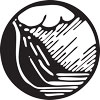
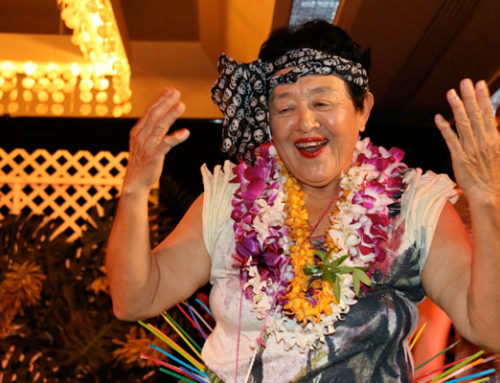
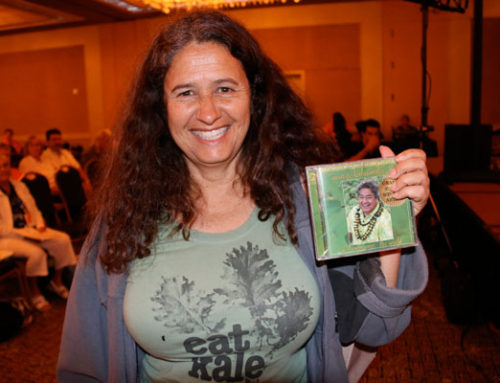
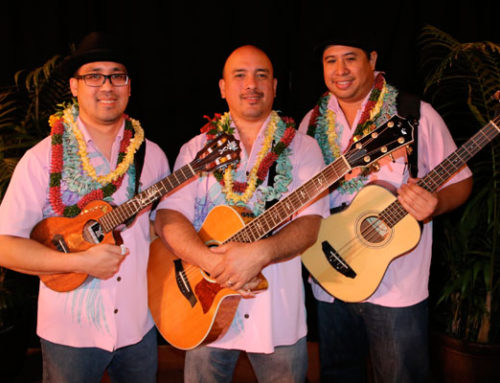
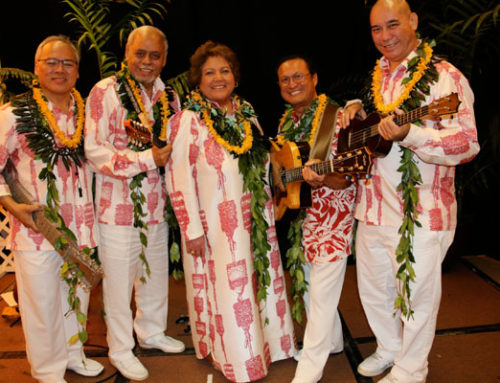
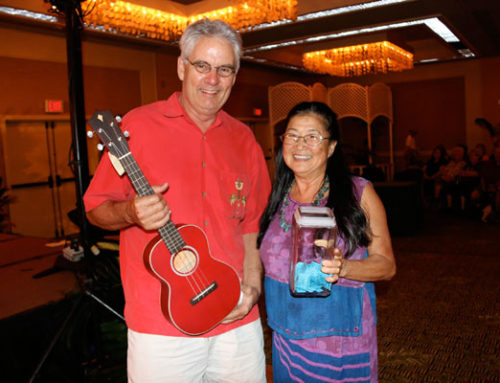
Leave a Reply